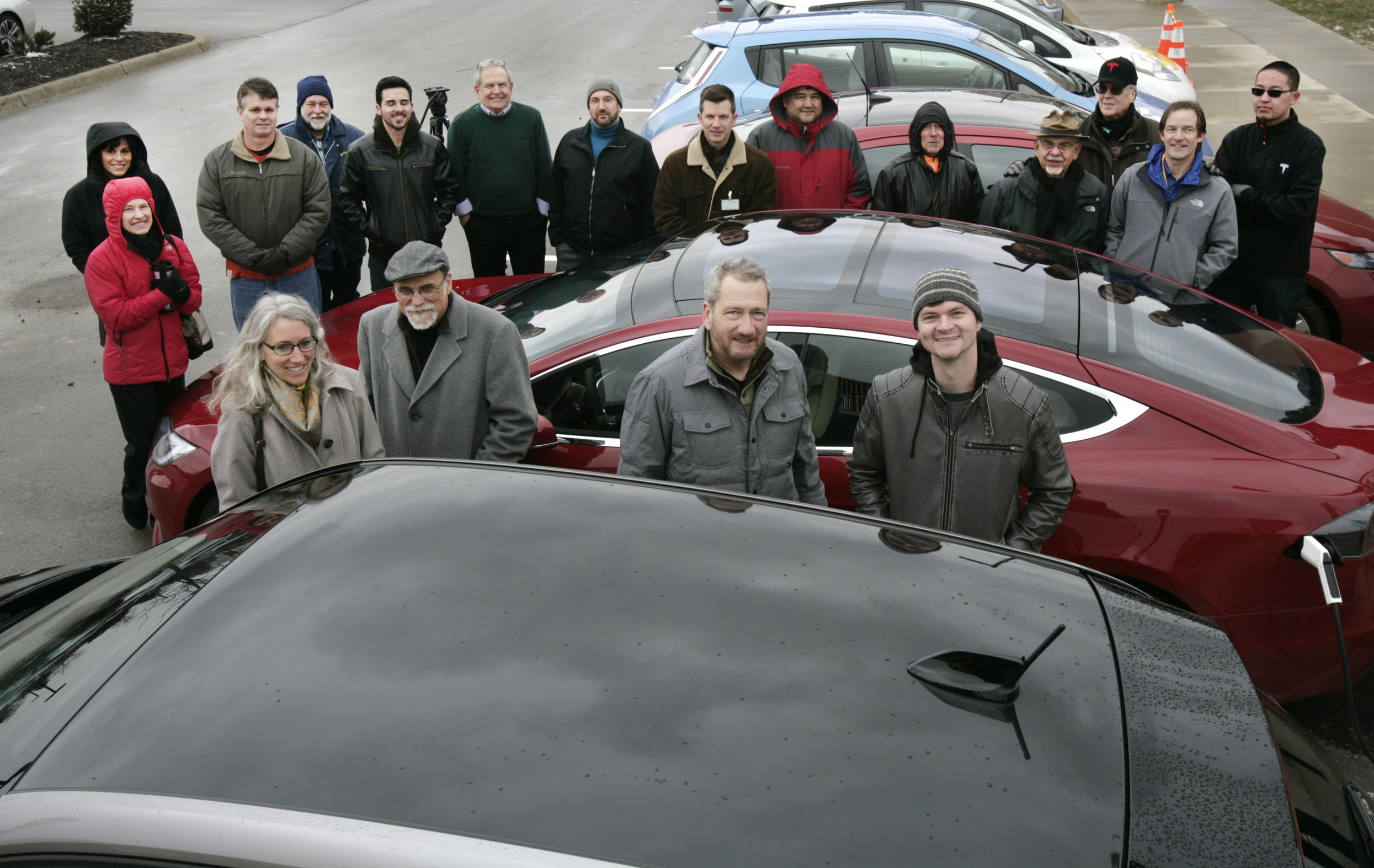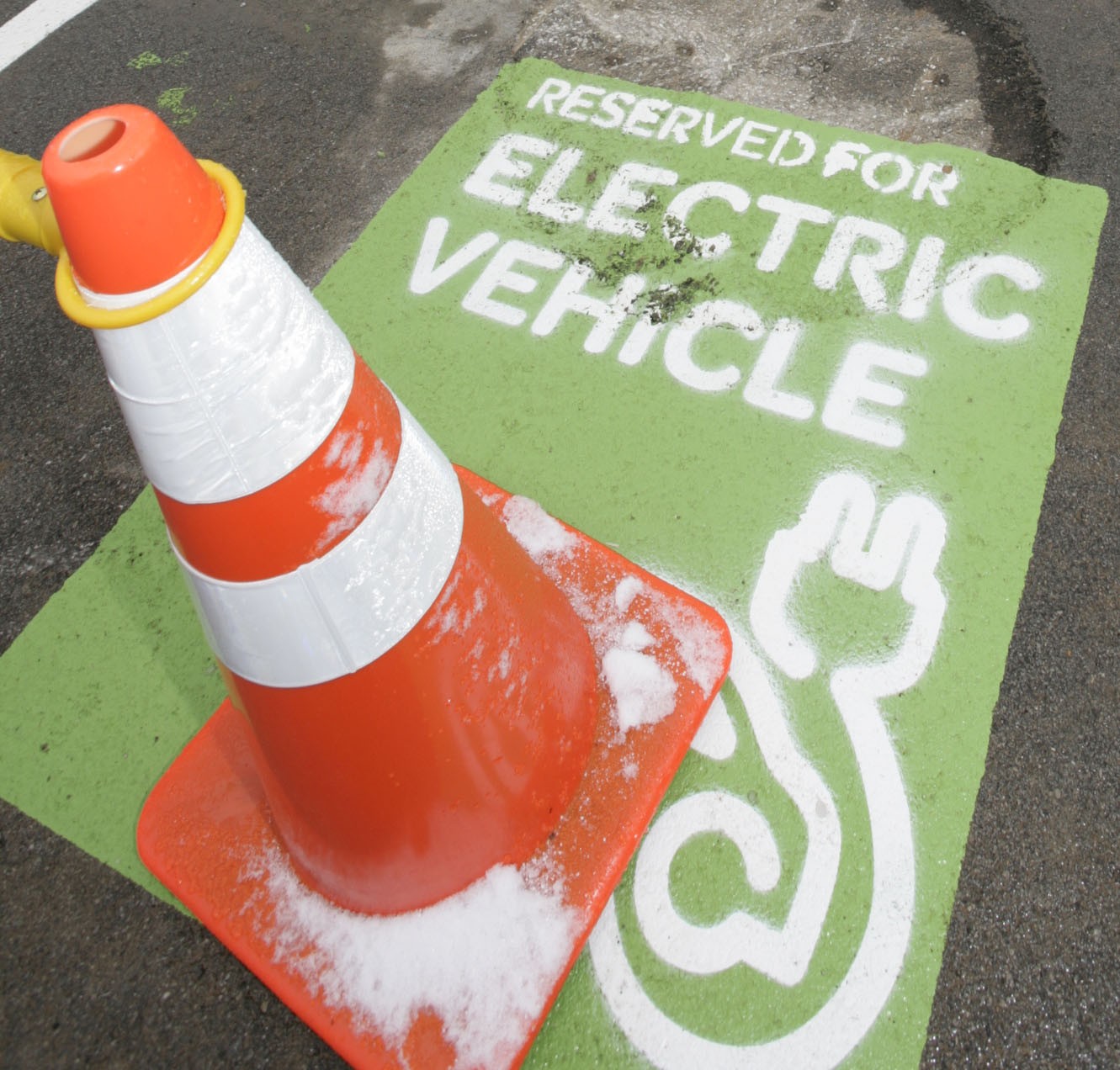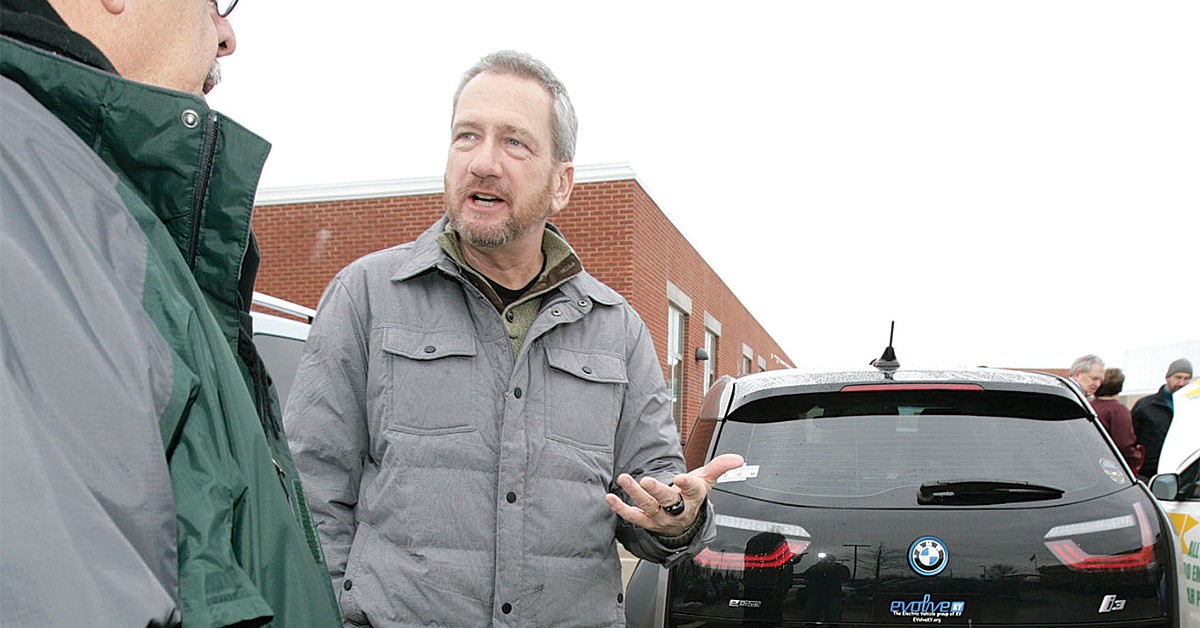For Cody Stratton, the idea of getting an electric car was born from, of all things, a UofL ethics class. His professor was discussing the handful of companies with which he wouldn’t do business. On that list was General Motors, and he cited the movie “Who Killed the Electric Car.” It’s about GM’s ill-fated attempt in the late ‘90s to mass-produce an electric car. Drivers loved the sleek, fun vehicle, but after their leases were up, the company famously and abruptly took the vehicles back and crushed them. The company’s explanation was that the battery technology wasn’t ready for prime time.
“You start out so enthusiastic,” said Stratton about watching the film. “And then towards the end of the movie, you’re like, ‘I guess we’re never getting electric cars.’”
He may be wrong about that.
While electric cars still make up less than 1 percent of all cars owned in the U.S., they are on the upswing in a major way. And, it’s not just a bunch of liberal tree-huggers like me who think this. Oil giant BP projects a hundredfold increase in electric vehicles by 2035 — which would mean 100 million vehicles globally. And, it is a moving target. Last year, BP predicted only 70 million vehicles by 2035.
The landscape of electric vehicles, or EVs, is changing. New long-range EVs are starting to be produced at competitive prices. Utilities, community groups and governmental organizations are beginning to offer community charging stations, and the grid is starting to get cleaner as more renewable sources enter the mix.
Still, we are just starting down this long road. First-generation EVs are great as daily drivers, but can’t easily be driven out of Kentucky, due to a lack of fast-charging stations. And, even in more-expensive Tesla vehicles, with longer ranges, advanced planning is necessary when taking long trips, because stopping at their charging stations is essential.
Stratton’s own electric car journey started just over three years ago. The 29-year-old treasury specialist at Eclipse Bank saw an ad for the Nissan Leaf and was impressed. “I thought it was the coolest thing,” he recalled. “I really want America to be energy independent. I don’t want to destroy the environment or do business with bad people to get fuel.”
“I’ve had a whole hodgepodge of cars over the years, some of which were extremely modified to be ultra-high performance,” he said. “They were horribly unreliable. There was something that was so appealing about a car that really can’t have much go wrong with it.”
Stratton isn’t alone.
At the conclusion of National Drive Electric Week, in mid-September of last year, there were 502,000 plug-in cars sold nationally. Just a month later, that number had risen by more than 15,000. Now, according to Plug In America, a nonprofit advocacy group, that number — including all EVs sold since December 2010 — is pushing 600,000. Far more are in California than in Kentucky. According to the Electric Power Research Institute, an independent nonprofit organization, only about 900 plug-in electric hybrid vehicles and battery electric vehicles have been registered here since 2010.
With longer-range, second generation vehicles coming, such as Tesla’s Model 3 and Chevrolet’s new all-electric Bolt — both with a driving range of over 200 miles on a full charge and both around $35,000 (before tax incentives) — demand for plug-ins has grown. There are already about 400,000 reservations ($1,000 deposit) for Tesla’s Model 3, which is due to begin production this year.
Interest is growing locally, too.

‘Isn’t that cool, because we are electric’
I cofounded Evolve KY, Kentucky’s electric-vehicle group, just over two years ago to give a voice to EV owners and work towards getting more community charging stations installed. The group also hopes to increase the sales of electric vehicles and educate the public on the features and benefits of driving electric. We hold monthly meetings for EV owners and enthusiasts to discuss anything and everything EV-related. We began with about a half-dozen people attending the meetings, but now easily over 24 members attend regularly.
One reason people buy electric cars is to set a good example for future generations.
Developer Gill Holland, known for sparking redevelopment of a section of Market Street into the Nulu neighborhood, recalled one cold, dark morning when he was driving his young children to school. “We were in the car and stuck behind a train on Highland Avenue. And the car in front of us — you could just see the smoke pouring out of the rear exhaust pipe.” said Holland. “I said, ‘That smoke is not good for the Earth, and now look behind our car and what do you see?’ And they said, ‘Nothing.’ I said, ‘Isn’t that cool, because we are electric.’”
Holland also pointed out that EVs are good for the economic health of communities. There is an electric car charger at The Green Building in Nulu, which draws some people specifically to town to eat or shop, because they know they can charge their cars at the same time.
Range-anxiety
While the vast majority of EV drivers charge at home and start the day with a full charge, our society still looks to the gas station model of fueling a vehicle. Often one of the first questions an EV owner is asked is: “Where can I charge my car?” And because EVs have less range than do their gas and diesel counterparts, range-anxiety can be an issue. Community charging stations may help to ease that anxiety, as drivers can top off their cars, much like people top off their phones and laptops at area cafes. Several EV charging stations existed in the community when Evolve started, but many were at car dealerships — not necessarily the most convenient or desirable place for charging. That’s because dealerships typically are located next to, you guessed it, other car dealerships — not shops, restaurants or parks where a person can spend 45 minutes or more while a car is charging.
Evolve KY launched an Adopt a Charger program: A potential charger site owner can fund it, or Evolve can search for sponsors to underwrite the cost. Site sponsors would get a tax-deduction. Evolve KY has placed community chargers through this program at The Green Building in Nulu, in the Portland neighborhood, at the Highland Green Building off Bardstown Road and at the YMCA at Norton Commons, and has more sites in the works. All Adopt a Charger sites are fee-free to the EV driver.
LG&E–KU will be placing 10 chargers in its LG&E territories and 10 in its KU territories. Of those 20, two community stations have been installed in Lexington and three in Louisville. Charging at the LG&E stations costs $3.12 per hour. In gasoline terms, that translates to roughly $7.50 per gallon for someone with an early-model Nissan Leaf or a Chevy Volt, and $3.75 per gallon for a newer Nissan Leaf. Some in the EV community worry the price may deter users from using the chargers and discourage EV adoption. By comparison, when an EV driver charges at home, they can expect to pay about 25 to 50 cents an hour for the electricity. Liz Pratt, public relations specialist at LG&E-KU, defended the cost, saying it is calculated so that it takes into account all customers, not just those using EVs. “The cost of the stations are paid for by the hourly fee and by customers who are voluntarily hosting stations. This really helps ensure that our customers who aren’t EV drivers aren’t subsidizing the cost of the EV stations,” Pratt said.
The Parking Authority of River City has placed two Level 2 chargers (which provides a complete charge typically in four hours or less) at its Clay Commons garage, two Level 2 chargers at its First and Main streets garage, two Level 2 chargers at its Glassworks garage and a Level 1 charger (a slower charger that adds about 25 to 40 miles in eight hours) at its Jefferson Centre garage. The chargers are free to use when drivers pay to park. The authority is working towards having at least one or more EV charging spaces (Level 1 or 2) at all of its garages.
While Level 2 chargers are important, DC Fast Chargers charge cars much more quickly. Tesla has been busy installing a network of Tesla Supercharger stations (an extremely expensive undertaking) in North America and beyond. These stations have multiple Superchargers, which can charge a Tesla Model S or Model X (and eventually a Model 3) from empty to full in minutes. There are five Tesla Supercharger stations in Kentucky (London, Bowling Green, Lexington, Kuttawa and Louisville). The Louisville spot is located at Sullivan University right near the highway and has a total of eight Superchargers. It is located near a Heine Bros. cafe, several restaurants and other businesses.
“Superchargers are for people traveling,” said Sullivan University President Glenn Sullivan.
Sullivan drives a Tesla Model S and, like all Tesla drivers in Louisville, he wanted a Supercharger station in the city. Tesla visited his location, and liked the proximity to the highway and the local businesses, so chargers were built there. At this point, it’s rare to see a lot of Teslas charging there at once. But looks can be deceiving. Since they can charge so quickly, drivers don’t linger too long. Sullivan said weekends are busier, because that’s when people travel. He added that he expects these local chargers will be used more often when Tesla ramps up production and adds new and less expensive models to their lineup.
Another piece of the puzzle is workplace charging for employees.
LG&E recently installed an EV charger at Yum! Brands’ restaurant support center. “It’s an idea we’ve been batting around for the past three to four years,” said Roger McClendon, Yum! Brands’ chief sustainability officer. While no employees at that location currently drive EVs, Yum! hopes the charger will encourage some to do so. It can charge two cars simultaneously, and an additional charger can be added if demand warrants. “We are thinking it’s a build it, and they will come philosophy,” McClendon said.
“It’s part of saying we are willing to invest, not only for the benefit of our employees, but for the benefit of our community,” said McClendon.

Not all EVS are Te$las — phew!
Say “electric car,” and some conjure up the image of a shiny red Tesla zipping down the road. But that’s only part of the story. What many people don’t realize is that the price of many new electric cars is not too different from their gas or diesel counterparts, especially if you factor in the fuel and maintenance savings.
I’ve had my Nissan Leaf for just over two years. The first year, I spent $17 on my yearly maintenance car checkup (rotating tires). The second year — just over $300 (tire rotation, changing a cabin filter and refreshing the brake fluid). Fewer parts means less can go wrong. And since the first generation of EVs has been around for a few years now, there’s an aggressive used-car market. It isn’t unusual to see used Nissan Leafs in near-perfect shape with low miles selling for $7,500 to $10,000.
“I think for the first time, it’s opened up to a much bigger group of our population,” said Bob Hook III of Bob Hook Chevrolet. “There have been a lot of people who probably would have considered an electric vehicle, but it has been price prohibitive.”
The Chevy Bolt, an all-electric car with an EPA estimated range of 238 miles, is now sold at dealerships on the West Coast, with prices starting at just under $37,500 before tax incentives. Hook said he will start to take orders for the car in July for August delivery.
For people with relatively low incomes, or who live on fixed incomes, EVs can be beneficial, too. Louisville Metro Housing Authority’s Sheppard Square Hope VI Revitalization project recently replaced a 70-year-old housing complex in Smoketown with energy-efficient, mixed-income housing. It also now hosts nine Level 2 chargers for use by residents and the general community. Charging is free for the first hour, with a $2 flat fee for additional charging. No current residents own EVs, but the housing authority plans to bring in volunteers from Evolve KY this spring to talk about how EVs can save residents money.
And remember: EVs aren’t just cars. There are also electric buses, motorcycles, bikes, skateboards, scooters and unicycles. Evolve even has a member who has an electric (and solar-assisted) houseboat. Recently, TARC added six all-electric buses, bringing its zero-emissions vehicles to 15, making it one of the largest electric bus operators in the country. As a result, about 100,000 gallons of diesel fuel a year and the resulting air pollution are eliminated.
Is this all too good to be true?
The Achilles heel for EVs has always been the batteries — their eventual replacement and disposal. Early Nissan Leafs (2011 and 2012 models) were plagued by premature battery degradation in hot climates. But for newer EVs, battery technology has improved a great deal, and now batteries last longer without any serious shortening of driving range. And when batteries are eventually replaced, they are recycled. So in essence, if the rest of the car is well-maintained, getting a new battery pack is like getting a new car. Nissan has a five-year, 60,000-mile warranty on battery packs, but real-world examples show much better performance than that. There is a 2013 Nissan taxi in the United Kingdom that has surpassed 100,000 miles, has carried about 25,000 fares, is on its original set of brake pads and its battery has 98 percent of its life left.
Detractors also say that EVs simply have “a longer tailpipe” — power plant smokestacks. It is true that many EV drivers are driving only as clean as the grid they are plugging into. Here, in Kentucky, with an electric mix that has fewer renewables than does California, our EVs are driving dirtier. But EVs are the only modern-day vehicle that actually gets cleaner as the grid does. Additionally, EV drivers can get solar panels installed on their homes’ roofs, which essentially makes their cars solar-powered. But even using power that’s mostly generated by coal, it has been shown that EVs are still much cleaner than their gas and diesel counterparts. The Union of Concerned Scientists, in its 2015 report “Cleaner Cars from Cradle to Grave,” concluded that, over its lifetime EVs are over 50 percent cleaner as compared to gas cars.
At the end of his lease
As for driver Cody Stratton, the lease on his Leaf came up in late December, and he turned it in. He’s been driving his 1998 Mitsubishi Eclipse that’s been in storage for the past three years. He said it seems like it is the exact opposite of his Leaf ‚ it’s loud and small, and every time he turns around, it needs work. Not a great daily commute vehicle. So, even thought there aren’t any lease payments, he doesn’t think it is really saving him money.
He started looking for another car, but is waiting for the right one and a good deal. Right now, he sees the new Chevy Bolt as his best option, and he is reading articles and watching car review videos. His grudge against GM has faded, and he is looking forward. Stratton feels that the company that makes the best product deserves his business, and the longer range of the Bolt is attractive.
One thing’s for certain, he said: His next car will be electric.






